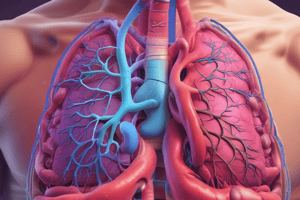Podcast
Questions and Answers
If Patm = 0 mmHg and Palv = -2 mmHg, what is happening?
If Patm = 0 mmHg and Palv = -2 mmHg, what is happening?
- Air is flowing out of the lungs
- Air is flowing into the lungs (correct)
- Lungs are collapsing
- There is no airflow
Transpulmonary pressure increases by 3 mmHg during a normal inspiration. Which of the following is true?
Transpulmonary pressure increases by 3 mmHg during a normal inspiration. Which of the following is true?
- The compliance of the lung of subject A is less than that of subject B
- Both subjects have the same lung compliance
- The compliance of the lung of subject B is less than that of subject A (correct)
- Neither subject has compliance issues
Which of the following will increase alveolar PO2?
Which of the following will increase alveolar PO2?
- Decreased alveolar ventilation
- Increased atmospheric pressure
- Increased alveolar ventilation with no change in metabolism (correct)
- Increased metabolism
Which of the following will cause the largest increase in systemic arterial oxygen saturation in the blood?
Which of the following will cause the largest increase in systemic arterial oxygen saturation in the blood?
In arterial blood with a PO2 of 60 mmHg, which of the following situations will result in the lowest blood oxygen saturation?
In arterial blood with a PO2 of 60 mmHg, which of the following situations will result in the lowest blood oxygen saturation?
Peripheral and central chemoreceptors both increase firing when arterial PCO2 increases.
Peripheral and central chemoreceptors both increase firing when arterial PCO2 increases.
If a patient is unable to produce surfactant, will her intrapleural pressure have to be more or less subatmospheric during inspiration compared to a healthy person?
If a patient is unable to produce surfactant, will her intrapleural pressure have to be more or less subatmospheric during inspiration compared to a healthy person?
Why must a person floating on the surface of the water and breathing through a snorkel increase his tidal volume and/or breathing frequency?
Why must a person floating on the surface of the water and breathing through a snorkel increase his tidal volume and/or breathing frequency?
Are the new steady-state values of alveolar P O2 and P CO2 after a healthy person doubles their alveolar ventilation higher or lower than normal?
Are the new steady-state values of alveolar P O2 and P CO2 after a healthy person doubles their alveolar ventilation higher or lower than normal?
Could hypoventilation due to respiratory muscle weakness cause alveolar PO2 to be higher than normal?
Could hypoventilation due to respiratory muscle weakness cause alveolar PO2 to be higher than normal?
Will a person's thickened alveolar membranes necessarily result in low arterial PO2 at rest?
Will a person's thickened alveolar membranes necessarily result in low arterial PO2 at rest?
How much will the oxygen content of arterial blood increase when a person is breathing 100% oxygen compared to room air?
How much will the oxygen content of arterial blood increase when a person is breathing 100% oxygen compared to room air?
Which of the following have higher values in systemic venous blood than in systemic arterial blood?
Which of the following have higher values in systemic venous blood than in systemic arterial blood?
What is the ventilation pattern in patients with severe uncontrolled type 1 diabetes mellitus?
What is the ventilation pattern in patients with severe uncontrolled type 1 diabetes mellitus?
Flashcards are hidden until you start studying
Study Notes
Airflow and Lung Compliance
- Negative alveolar pressure (Palv = -2 mmHg) relative to atmospheric pressure (Patm = 0 mmHg) indicates that air flows into the lungs.
- During normal inspiration, transpulmonary pressure can increase by 3 mmHg, affecting lung volume compliance: subject A with 500 mL inspired demonstrates greater compliance than subject B with 250 mL.
Alveolar Gas Dynamics
- Increased alveolar ventilation without changes in metabolism raises alveolar PO2.
- A significant rise in systemic arterial oxygen saturation occurs when arterial PO2 increases from 40 to 60 mmHg due to the steep portion of the oxygen-hemoglobin dissociation curve.
Factors Affecting Oxygen Saturation
- Low arterial blood oxygen saturation at PO2 of 60 mmHg can arise from elevated temperature, acidosis, and increased 2,3-DPG, which shift the oxygen-hemoglobin curve downward.
- Both peripheral and central chemoreceptors respond to increased arterial PCO2, triggering enhanced respiratory ventilation due to respiratory acidosis.
Surfactant and Intrapleural Pressure
- A patient lacking surfactant requires a more subatmospheric intrapleural pressure during inspiration, due to decreased lung compliance needing greater transpulmonary pressure for inflation.
Ventilation Adjustments
- An individual using a snorkel must increase tidal volume and/or breathing frequency to maintain adequate alveolar ventilation, as snorkel volume adds to dead space.
- Following a doubling of alveolar ventilation, P O2 increases while P CO2 decreases compared to normal values.
Hypoventilation and Discrepancies in Gas Levels
- In cases where alveolar PO2 is normal yet arterial PO2 is low, hypoventilation is not the cause; instead, potential issues include diffusion impairment, shunting, or ventilation-perfusion mismatches.
Diffusion and Blood Gas Exchange
- Thickened alveolar membranes may not lead to low arterial PO2 at rest; however, during exercise, reduced diffusion time increases the likelihood of unequal equilibration, resulting in lower arterial PO2.
Oxygen Content in Blood
- Breathing 100% oxygen only marginally increases arterial blood oxygen content due to hemoglobin already being nearly saturated at normal room air levels.
Metabolism and Venous Blood Composition
- Systemic venous blood exhibits higher levels of plasma PCO2, erythrocyte PCO2, bicarbonate concentrations, hydrogen ion concentrations, and carbamino concentrations compared to arterial blood, due to metabolic byproducts.
Ventilation in Diabetes Patients
- Type 1 diabetes patients often experience profound hyperventilation leading to increased arterial PO2 and decreased arterial PCO2, triggered by elevated hydrogen ion concentrations from organic acid production.
Studying That Suits You
Use AI to generate personalized quizzes and flashcards to suit your learning preferences.




